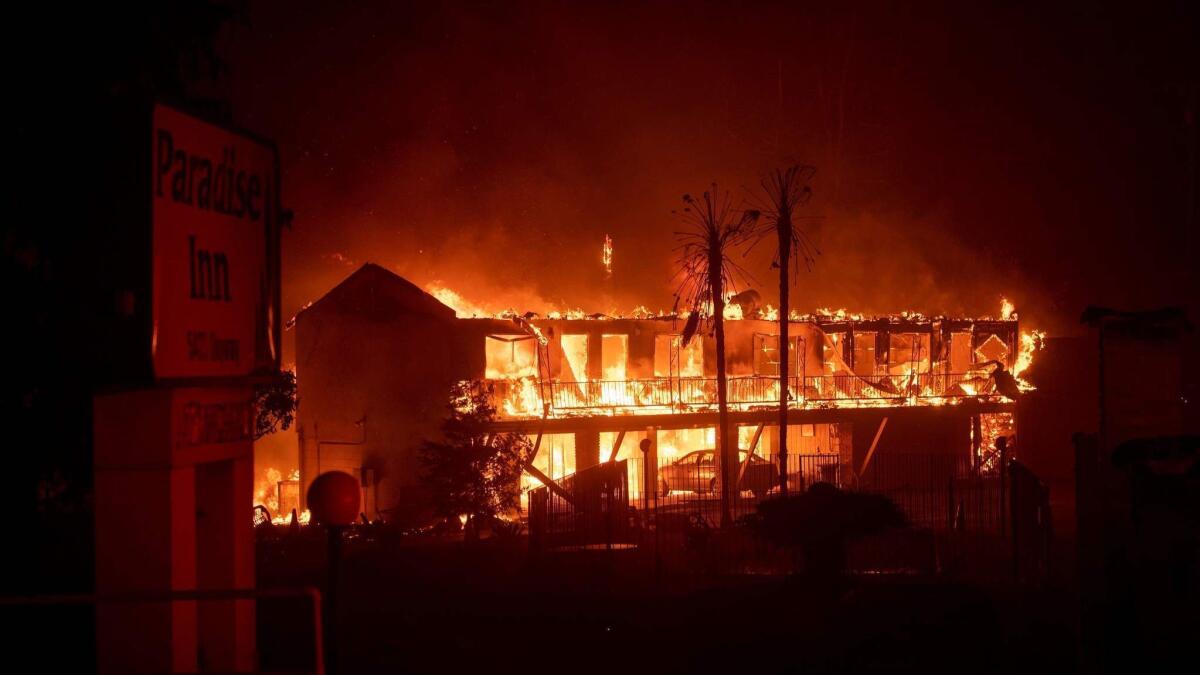PG&E looks to cap wildfire costs at $18 billion through its bankruptcy plan

- Share via
California utility giant PG&E Corp. is proposing to cap the wildfire liabilities that forced it into bankruptcy at about $18 billion — less than half of what victims and insurers have said they’re owed.
The power company laid out the cap as part of a reorganization plan filed Monday that would have it exiting the biggest utility bankruptcy in U.S. history by next year. As proposed, the parent of Pacific Gas & Electric Co. would raise a combination of debt and equity to cover the liabilities it’s facing after its equipment was blamed for igniting blazes that killed more than 100 people and destroyed tens of thousands of structures in 2017 and 2018.
PG&E’s plan kicks off what may prove to be the most contentious phase yet of a bankruptcy that has already attracted some of the biggest names in the financial world, including Pacific Investment Management Co. and Elliott Management Corp.
The company’s January bankruptcy filing has been described as climate change’s largest business casualty to date. Wildfire victims, state politicians, activist investors and ratepayer advocates have spent the last seven months clashing over the future of the company.
“We currently believe that the caps being outlined in our plan of reorganization are sufficient to satisfy the claims against the company,” PG&E Chief Financial Officer Jason Wells said by telephone. The company is, however, open to refiling its plan to reflect what the courts determine as its liabilities, he said.
Complicating PG&E’s plan is the fact that claims tied to the blazes are getting tallied as part of a separate court process that’s only just begun.
Although the company has given its own estimates for wildfire claims, it may be months before the utility has a clear picture of its liabilities. A federal judge will oversee the process that will result in a more formal figure that will probably replace PG&E’s.
Estimates for the company’s wildfire liabilities have meanwhile proven to be wide-ranging: PG&E has said they may total less than $10 billion — after warning in the days leading up to its bankruptcy that they may exceed $30 billion.
Lawyers for fire victims said they may top $40 billion. Insurance companies claim PG&E owes them about $18 billion.
Any exit plan hinges on that estimate. The official tally could lead to an entire rewrite of PG&E’s reorganization. A total that’s higher than PG&E is capable of paying threatens to wipe out current shareholders because, under the U.S. Bankruptcy Code, fire victims would get paid in full first.
That puts PG&E in a tenuous position as key creditor groups clamor to pitch restructuring proposals to U.S. bankruptcy Judge Dennis Montali.
In August, Montali said he doesn’t expect PG&E’s plan to be the final version because some details aren’t yet available. But he said the company must present something credible or else he may open the door to rival ones.
The proposal “will almost certainly face opposition,” Bloomberg Intelligence analyst Negisa Balluku said in a note Monday, ahead of the filing made in federal court in San Francisco. PG&E has until June to get out of bankruptcy if it wants to participate in a statewide fund recently established to help utilities cover the cost of future fires.
PG&E’s plan has already hit some snags: A group led by Pimco and Elliott has been floating one plan that would all but wipe out the stakes of current stakeholders and hand control of the company over to the investor group. The investors have fought — so far unsuccessfully — to have their proposal considered by Montali.
On Friday, a measure that would’ve allowed the company to use tax-free state bonds to pay off its fire claims stalled in California’s legislature.
San Francisco, PG&E’s hometown, on Friday made a $2.5-billion offer for the company’s electrical equipment within the city. An irrigation district in California’s Central Valley has bid $116 million for assets in its own territory.
PG&E has rebuffed both propositions, saying San Francisco’s wasn’t in the best interests of customers and that the district’s offer was too low. While casting doubt on the prospects of either deal, PG&E didn’t outright reject them.
San Francisco officials see the proposal as an opportunity to save ratepayers money, eliminate layers of costs and fees and fulfill a long-held desire to break away from the company.
More to Read
Inside the business of entertainment
The Wide Shot brings you news, analysis and insights on everything from streaming wars to production — and what it all means for the future.
You may occasionally receive promotional content from the Los Angeles Times.










